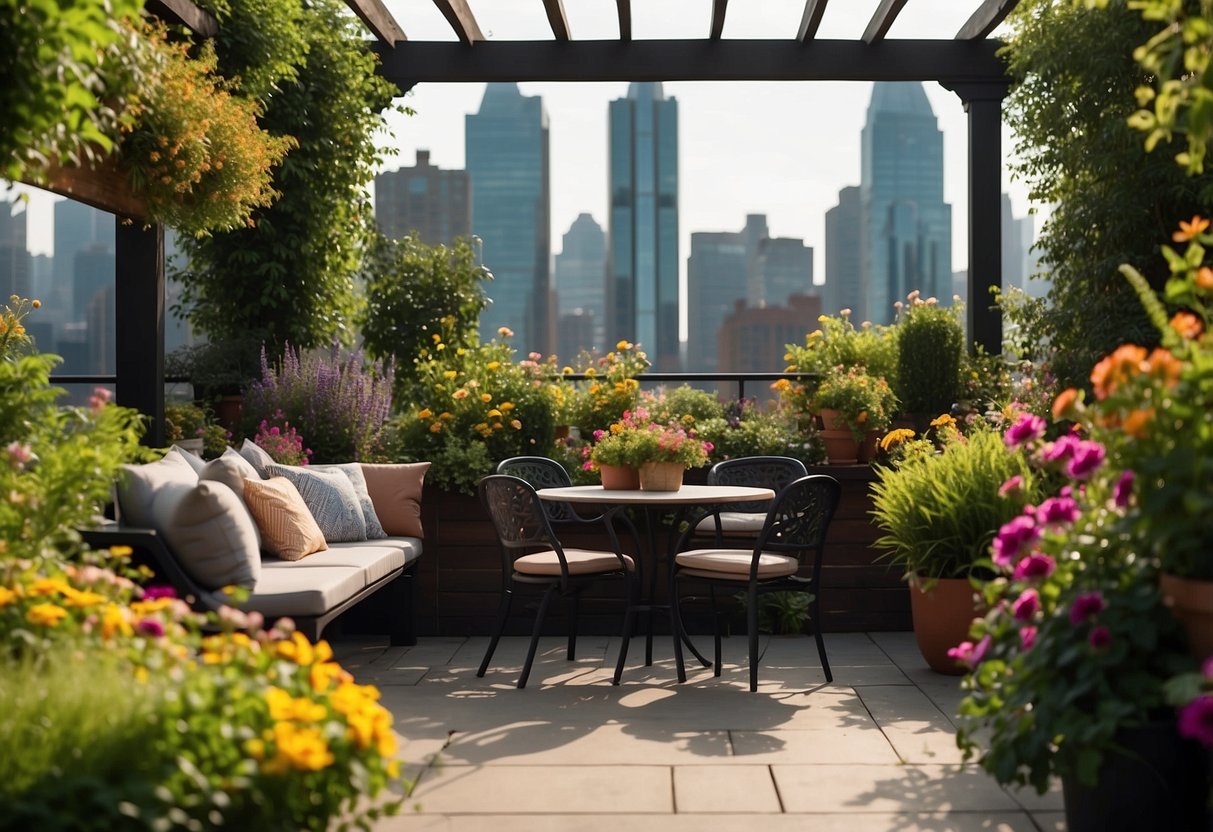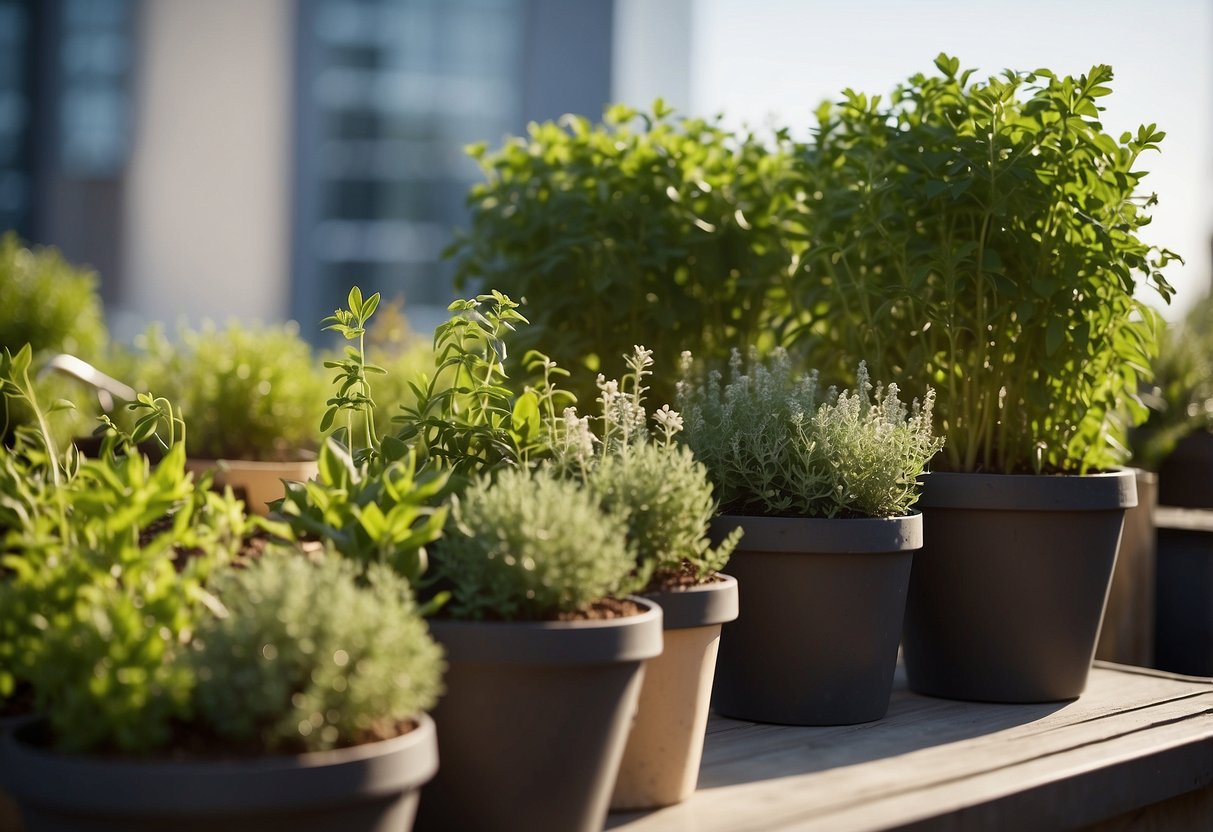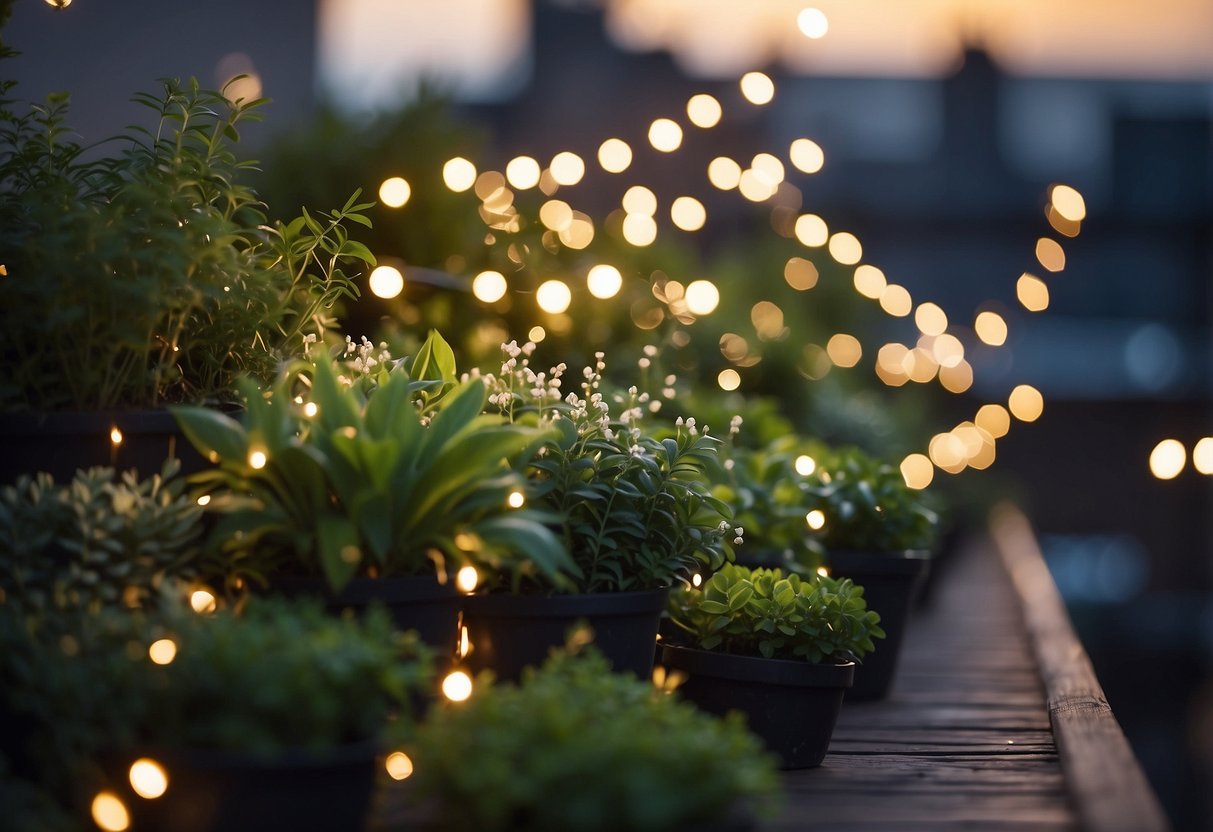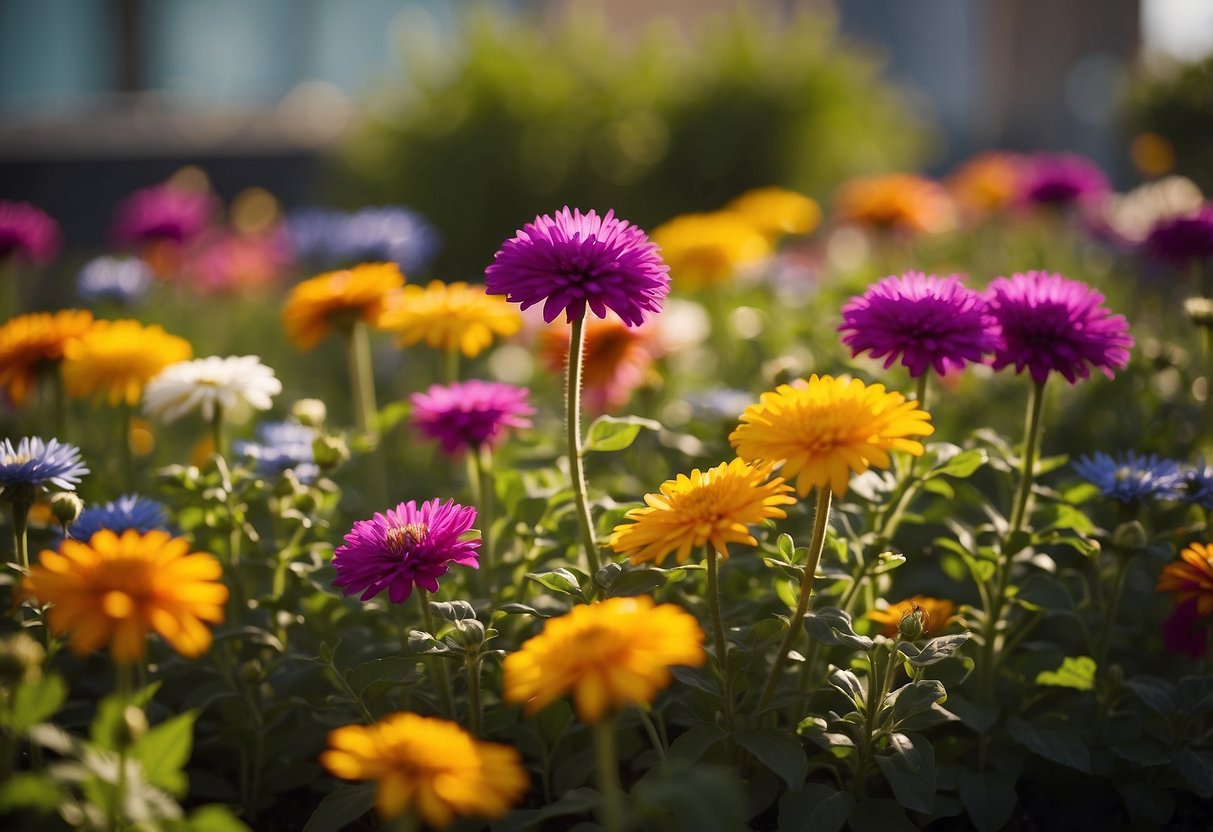Rooftop Garden Ideas: Transform Your Urban Space
Transforming your rooftop into a green oasis can be a rewarding project that adds beauty and functionality to your outdoor space. It’s a fantastic way to utilize unused space, giving you a personal sanctuary above the bustling city. A rooftop garden can provide you with a tranquil retreat right at home.

You’ll find that there are numerous creative ideas to explore, from lush greenery to minimalist zen designs. Whether you prefer a vibrant mix of plants or a serene place to unwind, the possibilities are endless. Your rooftop garden will not only enhance your home’s aesthetics but also contribute to the environment.
1) Vertical Plant Walls

Vertical plant walls are perfect for adding greenery to small rooftop spaces.
You can create a stunning display by attaching pots or planters to a wooden wall or fence.
Using a wire fence tower full of blooms is also a simple and effective way to brighten up your rooftop.
These walls are not only space-saving but also bring a beautiful touch of nature to your urban environment.
2) Succulent Gardens

Succulent gardens are perfect for rooftop spaces. They are low-maintenance and thrive in sunny conditions.
Consider creating a vertical succulent garden to save space. You can use wood shutters or other recycled materials.
You can also build a rain gutter succulent garden for a unique look. This is great for small spaces.
3) Herb Spiral Planters

Herb spiral planters are a fun and efficient way to grow herbs on your rooftop. They save space by spiraling upwards, allowing you to plant various herbs in a small area.
Use materials like old bricks or stones to create the spiral shape. The structure helps in better water drainage and provides different microclimates for different herbs.
Place sun-loving herbs like rosemary at the top, while moisture-loving plants like mint can go at the bottom. This arrangement makes it easier to manage your herbs and creates a visually appealing garden feature.
4) Container Trees

Container trees are a great way to add height and structure to your rooftop garden. They can be easily moved around to suit your design preferences.
Opt for dwarf or compact varieties that thrive in pots. For example, blue fescue works well as it stays shorter and stands up to windy conditions.
Lightweight containers made of plastic or fiberglass can reduce the load on your rooftop, making it easier to manage. Additionally, ensure the containers have good drainage to keep your trees healthy.
5) Fairy Light Accents

Adding fairy lights to your rooftop garden creates a warm and inviting atmosphere.
You can wrap them around railings or weave them through trellises and bushes.
Choose solar-powered ones to save energy and avoid the hassle of wires.
Fairy lights come in different colors and designs, so pick what matches your style.
For a magical touch, consider adding fairy garden accessories like tiny lanterns or figurines.
6) Upcycled Planters

Upcycled planters are a fun and eco-friendly way to use old items in your rooftop garden.
You can turn an old wheelbarrow into a charming planter. Toolbox planters, bathtub planters, and even rain boots can add unique style.
Hang a chandelier and use its shades as planters. Try using old tires or drawers, which provide ample space for your plants to grow. These creative ideas help reduce waste and give your rooftop garden a personal touch.
7) Hanging Fern Baskets

Hanging fern baskets can bring a touch of nature to your rooftop garden. They are perfect for adding greenery without taking up floor space.
Consider the Tiger Fern. Its fascinating fronds with metallic strips make it stand out. Another great choice is the Dallas Fern, which is compact and low maintenance.
You may also like the Boston Sword Fern, known for its blue-green foliage and ability to thrive indoors with bright, indirect light.
8) DIY Water Features

Adding DIY water features to your rooftop garden can make it a peaceful retreat. Simple container water gardens can be a great start. You can use planters, basins, or even a small pond setup.
Watching water flow from a vintage tap paired with a galvanized planter adds charm. These projects require minimal tools and can be done in a weekend.
Consider using a submersible pump to keep water circulating. Select plants like lilies, irises, or water hyacinths to complement your water feature. Find more ideas for DIY container water features and elevate your garden’s beauty.
9) Rooftop Pergolas

Adding a pergola to your rooftop garden can greatly enhance its appeal. Pergolas provide shade and create a cozy space, perfect for relaxing or entertaining.
You have various options like bamboo reed tops, which can give a rustic and bohemian feel. For a natural touch, a living roof can blend your pergola into the garden.
Adjustable louvered roofs offer flexibility, allowing you to control the amount of sunlight and shade. Consider composite pergolas if you want a modern look that requires little maintenance.
10) Colorful Flower Beds

Adding colorful flower beds to your rooftop garden can make the space vibrant and inviting.
Using a variety of flowers can attract birds and butterflies, turning your garden into a lively scene. You can plant flowers in rows for a rainbow effect, which looks stunning against the urban background.
Consider mixing flowers with different blooming seasons so your garden remains colorful all year round. Opt for native plants for better growth and less maintenance. For more ideas on setting up your own colorful flower beds, check out these rooftop flower bed ideas.
Benefits of Rooftop Gardens

Rooftop gardens provide several advantages. They help the environment, improve your health, and make your space more attractive and enjoyable.
Environmental Advantages
Rooftop gardens can make a significant positive impact. They help reduce air pollution by capturing dust and pollutants through plant leaves. The plants on a rooftop garden absorb carbon dioxide and release oxygen, which is beneficial for urban areas with high pollution levels.
Rooftop gardens also aid in energy conservation. They provide insulation for buildings, reducing the need for air conditioning in summer and heating in winter. This lowers energy consumption and decreases your utility bills.
Water management is another key benefit. Rooftop gardens absorb rainwater, reducing runoff and lowering the risk of urban flooding. This can ease the burden on city drainage systems.
Health and Wellness Benefits
Creating a rooftop garden improves your physical and mental well-being. Gardening acts as a form of exercise, helping you stay active and burn calories. It’s a great way to get outside and move your body.
Spending time in a rooftop garden can reduce stress and anxiety. Being surrounded by greenery helps you feel calm and relaxed. The fresh air and natural environment contribute to a better mood and overall mental health.
Access to fresh, home-grown produce is another wellness benefit. Growing your own vegetables and herbs ensures you have healthy, organic food readily available. This can improve your diet and encourage you to eat more nutritious meals.
Aesthetic and Recreational Value
Rooftop gardens transform your space into a beautiful, green oasis. They add natural beauty to what might otherwise be a dull, concrete area. This enhances the visual appeal of your home or building.
These gardens provide a unique recreational space. You can use your rooftop garden for social gatherings, barbecues, or simply relaxing with a book. It becomes a peaceful retreat where you can unwind after a long day.
Additionally, a well-designed rooftop garden can increase property value. People appreciate the added green space, and it can make your property more attractive to potential buyers or renters.
Planning Your Rooftop Garden

To create a thriving rooftop garden, you need to evaluate the space, select the best plants, and ensure the structure can support your garden.
Assessing the Space
Start by measuring the area available for your rooftop garden. Take note of sunlight exposure as this will influence plant selection. For example, tomatoes and peppers need full sun, while leafy greens like spinach can manage with partial shade.
Check accessibility to water sources. If it’s not easy to bring water up, you might need a hose or a rainwater collection system. Look at wind exposure, too. Rooftops can be windy, which can harm delicate plants. Consider using screens or windbreaks to protect your garden.
Choosing the Right Plants
The right plants depend on your climate and the amount of sunlight your rooftop gets. Select container-friendly plants like tomatoes, peppers, and eggplants for vegetables. Herbs like basil, mint, and thyme are also excellent options for small spaces.
You can plant vines such as Ivy and climbing hydrangeas to cover walls with greenery. Ensure you choose drought-resistant plants if water availability is an issue. Root vegetables like carrots and radishes can be grown in deeper containers for variety.
Structural Considerations
Ensure your rooftop can support the weight of the garden. Consult with an engineer if you are unsure about the structural integrity. Heavy planters, soil, and water can add significant weight.
Use lightweight containers like plastic or fiberglass to reduce load. Install proper drainage systems to avoid waterlogging, which can damage your roof. Regularly check for leaks and address any issues promptly to maintain the health of both your garden and your building.
By planning carefully, you can create a rooftop garden that thrives and adds beauty to your space.
Maintenance Tips for Rooftop Gardens

Keeping your rooftop garden healthy requires regular attention. Focus on proper watering, maintaining soil quality, and adapting care practices to seasonal changes.
Watering Practices
Watering your rooftop garden correctly is essential. The wind and sun exposure make rooftop gardens dry out faster, so frequent monitoring is necessary. Early morning is the best time to water because it reduces evaporation and helps plants absorb water efficiently.
Use drip irrigation systems for consistent watering, especially for larger gardens. These systems deliver water directly to the roots, minimizing waste. If using containers, ensure they have drainage holes to prevent root rot.
Grouping plants with similar watering needs can also simplify your routine, keeping your garden healthy and vibrant.
Soil and Fertilization
Maintaining soil health is crucial for a thriving rooftop garden. Since rooftop gardens often use containers, soil can become compacted. Use a lightweight, well-draining soil mix to ensure good aeration and root growth.
Fertilize regularly to replenish nutrients. Organic options like compost or worm castings are excellent choices. These fertilizers improve soil structure and provide a slow-release of nutrients.
Every few weeks, check the soil pH and nutrient levels to adjust your fertilization plan as needed. Healthy soil leads to healthy plants.
Seasonal Care
Adapting your care routine to the seasons helps your garden thrive year-round. In spring, inspect for winter damage and prune dead branches. As summer approaches, ensure adequate shading for sensitive plants.
In fall, remove spent plants and prepare the garden for winter by mulching to protect roots. For winter, consider growing hardy plants and use row covers to shield them from extreme cold. Regularly clearing snow off plants and structures will prevent damage.
By adjusting your maintenance practices to the current season, you can enjoy a lush, productive rooftop garden every month of the year.







